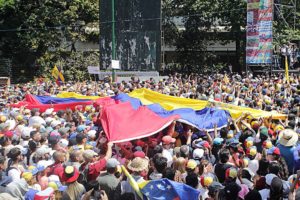As power returns to Venezuela, millions continue to suffer the consequences of aging infrastructure and severe system mismanagement
The days following one of the longest and most widespread blackouts in recent memory are still grueling for people all across Venezuela who are desperately trying to return to something that resembles normalcy. Over 70 percent of Venezuela’s population lost power on March 7. As of Thursday, March 14, Venezuela’s Information Minister, Jorge Rodriguez, declared that power has been fully restored. However, 20 percent of the country is still without adequate drinking water due to the loss of power to water pumps, and others have found their water has turned black due to water sitting stagnant during the outage.
What Happened
The blackout began on March 7 when an unidentified malfunction occurred at the massive Guri dam hydropower plant in eastern Venezuela, which generates 80 percent of the country’s electricity. In Venezuela’s energy system, electricity is transformed from low to high voltage in substations at one centralized plant for transmission all over the country where it is then converted back down to lower voltage for local distribution. Energy plants, like many of the critical infrastructure systems in Venezuela, have demonstrated a pattern of poor planning and mismanagement, as well as a lack of investment and oversight on the part of the Maduro Administration. Consequently, many energy analysts and power sector unionists contend that the failure was a disaster waiting to happen.
Response by Disputed Governments

President Nicolas Maduro blamed the US for organizing what he said was a sophisticated cyber attack on Venezuela’s hydroelectric power operations. On March 12, the Venezuelan authorities began investigating the leader of the opposing and internationally-recognized government, Juan Guaido. The administration also detained a prominent journalist, citing suspicion he had sabotaged the electric system. Foro Penal, a human rights group, said about 80 people had been detained by the government since Thursday in connection with the blackout. Additionally, the Chinese government offered to help Venezuela restore its power grid after hearing Maduro’s claims of US interference with their energy grid, implying that they may believe these claims.
Health and Safety
Opposition leader Juan Guaido claims that the Maduro government should be held responsible for 17 deaths that occurred when power was cut from hospitals. One witness described the tragedy of seeing hospitals forced to switch babies on respirators to manual pumping methods. Without pumps to distribute clean water, millions were left without reliable sources of potable water. Families resorted to collecting water in jugs from drains and polluted rivers. In some cities, pockets of violence and looting broke out over allocation of scarce resources. The cascading failures that have taken place all across Venezuelan society show the importance of building resilience into a nation’s infrastructure systems.
Going Forward
Electricity has now returned to an unconfirmed majority of the country, and is continuing to trickle back into Caracas, the capital and most populous city. Cascading failures of systems, as we’ve seen across Venezuela, is a problem with a solution. Systems that rely entirely on a the functioning of a single facility are drastically more vulnerable to disastrous disruptions than systems that incorporate fail-safes to prevent widespread infrastructure collapse from an isolated malfunction. In fact, many small countries that use similar distribution systems prioritize adding diverse generation or connecting with neighboring grids to increase redundancy and prevent single-point failure. However, Venezuela’s struggle to recover from this blackout was caused by far more than one technological misstep. As Tim Yardley, a senior researcher at the University of Illinois focused on industrial control crisis simulations, described it, “You have a maintenance issue and a manpower issue, because it’s extremely dangerous to reenergize a system if you have gear that hasn’t been maintained well.” Yardley’s claim echos the sentiments of countless engineers, specialists, diplomats, leaders, activists and others, who emphasize that aging and poorly structured infrastructure systems only compounded a problem that was caused by years of mismanagement by the Maduro government.
As the world continues to learn about and develop more systems of clean and renewable energy, world leaders must be adamant that these new systems and industries be built with the concepts of holistic resilience, system reliability, redundancy, and long-term sustainability always leading the discussion. If not, societies will face many more devastating disruptions, with even more widespread and long-lasting ramifications.
Sources
Why It’s So Hard to Restart Venezuela’s Power Grid
The struggle to live through Venezuela’s blackouts
Venezuela: power returns after blackout but normal service may be a long way off
Venezuela, Seeking Blame for Blackout, Finds Culprit in Opposition Leader
Venezuelan President Nicolas Maduro says power recovery will come ‘little by little’
‘Horror, fear, despair’: Venezuela’s oil capital shattered by ‘tsunami’ of violent looting
